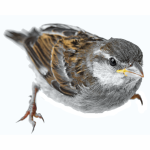House Sparrow
Passer Domesticus

What are house sparrows?
The house, or English sparrow, is not actually a sparrow at all. In fact, it is a member of the weaver finch family. The house sparrow originated in North Africa and was introduced to the US from Europe in 1850. It is the most common bird in the US.
House sparrows are readily identified by their small and stocky appearances. The upper parts of their bodies are reddish-brown and streaked with a brown color, while their underparts are gray. Females and young sparrows lack any distinctive markings; however, males have black throats, gray crowns, and chestnut-colored napes.
What is their behavior like?
House sparrows can be quite a nuisance. In rural areas, they damage poultry and livestock operations by destroying large amounts of feed. They can also destroy building insulation. In the city, sparrows inhabit parks, city streets, and zoos. They nest in and around residential and commercial buildings, and large flocks will frequently develop around warehouses, stadiums, and airport hangers. Around residential structures, they are pests in gardens and yards, frequently driving songbirds out of the area.
Sparrows nest and roost in flocks. All of their activity, including feeding, nesting, and roosting, is carried out within a 1-2 mile radius. As a result, sparrows will likely re-infest an eliminated area, even if population control is temporarily gained.
Sparrows will nest anywhere: in gutters, roofs, ledges, loading docks, on roof supports, trees, shrubs, inside buildings, and within commercial billboards and electric signs. The nests themselves are messy in construction and are made of twigs, grass, paper, and anything else they can carry. The same nests are often used over and over again. Nests that are constructed around power lines or in electrical substations can be serious fire hazards.
What is their biology?
House sparrows are prolific breeders– a few sparrows in the spring can produce a major infestation by midsummer. The process of nest-building and egg-laying begins in March and April in the northern U.S. and somewhat earlier in southern states. A female sparrow lays 3 to 9 eggs at a time and they hatch within 11 to 17 days. After hatching, the young birds are fledged at 14 days. Sparrows generally produce five broods per year, which means lots of new birds.
What do they eat?
Sparrows enjoy a varied cuisine, but their favorite is grain. Additionally, they like fruit, the buds of some trees and bushes, dandelion leaves, and clover. Sparrows typically eat 6 grams of food daily and feed insects to their young. In rural areas, sparrows thrive by feeding in cattle feedlots, dairies, and hog and poultry farms where food and shelter are plentiful. In the city, they depend on people for bread, fat, and other scraps.
